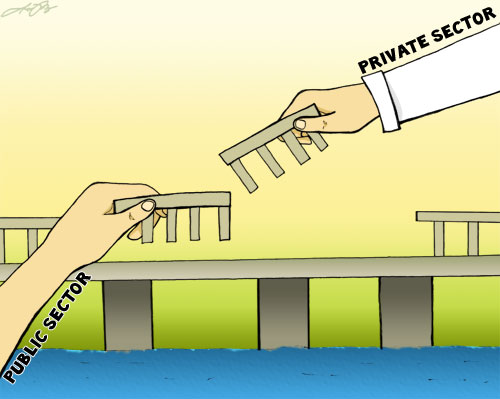Public-private partnership or PPP is again the catch phrase in the Philippines as a formula for carrying out large infrastructure projects, an engine for economic growth. As the country transitioned from the Arroyo administration to the Aquino administration, PPP turns out to be more telling in the political and public vocabulary. Former President Gloria Macapagal-Arroyo used to trumpet PPP during her term as a “main engine for national growth and development." This time, her successor, incumbent President Benigno Aquino III, puts PPP on top of his priority in the midst of his budget-strapped administration. Aquino signed Executive Order 8 on Sept 8, creating the PPP center to accelerate the financing, construction, and operation of infrastructure projects under his administration. The PPP center is Aquino’s version of the build-operate-transfer center under the Arroyo administration.

Graphics: Analyn Perez, GMANews.TV
In PPP projects, the state and the private sector collaborate to build a road, hospital, or airport, with the private company usually given the rights to run it for a certain period. In November, the Aquino administration initially bared its plan to invite private sector in some infrastructure projects under the PPP program. These include the creation of the Cavite-Laguna Expressway, Ninoy Aquino International Airport Expressway (Phase II), Light Rail Transit (LRT)-2 East Extension, LRT-1 South Extension. The government is also looking for investors who will privatize the LRT-1, MRT-3, and Laguindingan Airport in Misamis Oriental, and develop the New Bohol Airport, Puerto Princesa Airport, and New Legaspi (Daraga) Airport. With these projects in place, the Aquino Administration hopes that the growth of the Philippine economy would quicken in the near term. ING Investment Management Philippines head Paul Joseph Garcia said the PPP projects will serve as the primary growth driver for the Philippines in the next few years. “The infrastructure projects of the government will result in more jobs, higher income, and lower structural inflation," Garcia told reporters in a press conference in November. As such, the government should be transparent in implementing PPP projects so as not to turn-off private investors from coming into the Philippines, he added. Apart from Philippine conglomerates, expected investors in PPP projects may include foreign companies, particularly Chinese firms, which have rich experiences in developing big-ticket infrastructure projects. Wu Zhengping, economic and commercial counselor of the Chinese Embassy, told GMANews.TV that some Chinese firms are already in talks with the Philippine government on projects they want to participate in. Bulk of the PPPs lined up are infrastructure projects expected to ease travel and transport across the country. As a result, Tourism Secretary Alberto Lim earlier said that the projects will increase tourist arrivals from 3 million a year to 6 million by 2013. Especially now that the country’s tourism sector is in dire need of a facelift, boosting its infrastructure will surely help, Aquino said in August. However, given the long gestation period for large projects such as these, the impact of these PPP projects are not expected to be felt immediately. In an interview with GMANews.TV, former Finance Secretary Roberto de Ocampo pointed out that the effects of PPP projects on tourism and agribusiness would be felt two years from now. “As of the moment, these projects are still in their early stages. We can barely say [that] their effects will be felt too soon," De Ocampo said.
—VS/OMG, GMANews.TV 





